Silicon Motion SM2256 SSD Controller Preview: TLC for Everyone
by Kristian Vättö on June 17, 2015 8:15 AM EST- Posted in
- Storage
- SSDs
- TLC
- Silicon Motion
- SM2256
Sequential Read Performance
For full details of how we conduct our Iometer tests, please refer to this article.
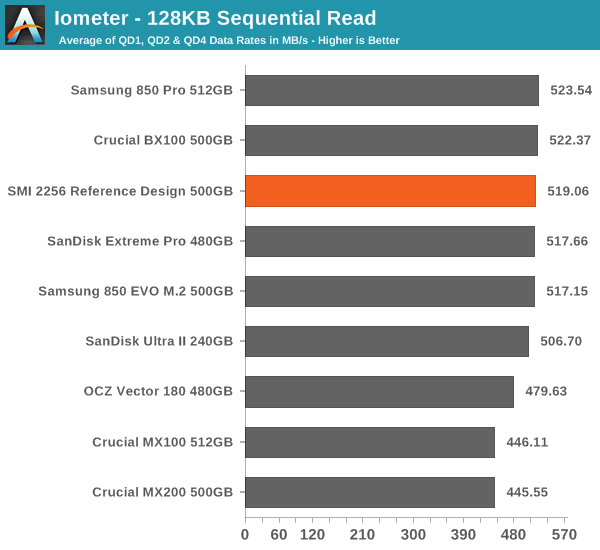
Despite the somewhat low random read performance, sequential read is strong in the SM2256.
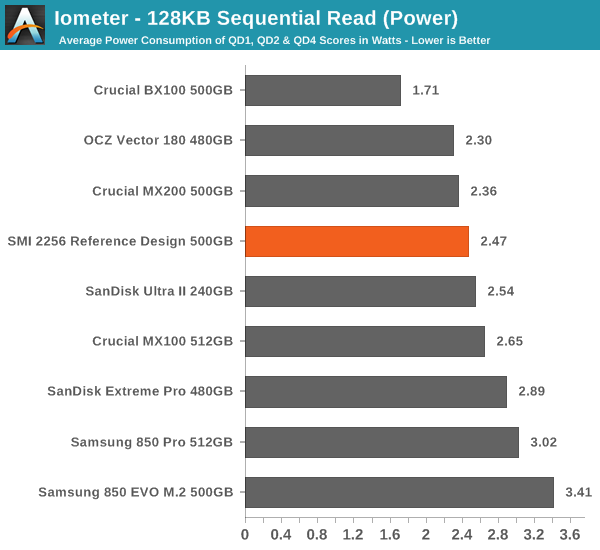
Power consumption is up from the SM2246EN, but still moderate.
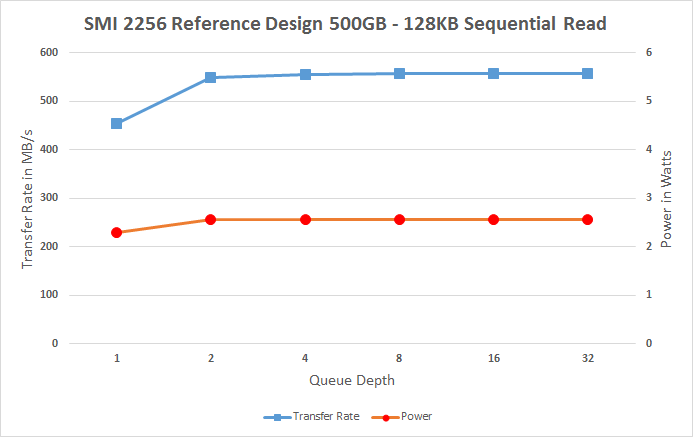 |
|||||||||
Scaling is also perfect in the sense that SM2256 reaches its maximum SATA 6Gbps limited throughput at QD2.
Sequential Write Performance
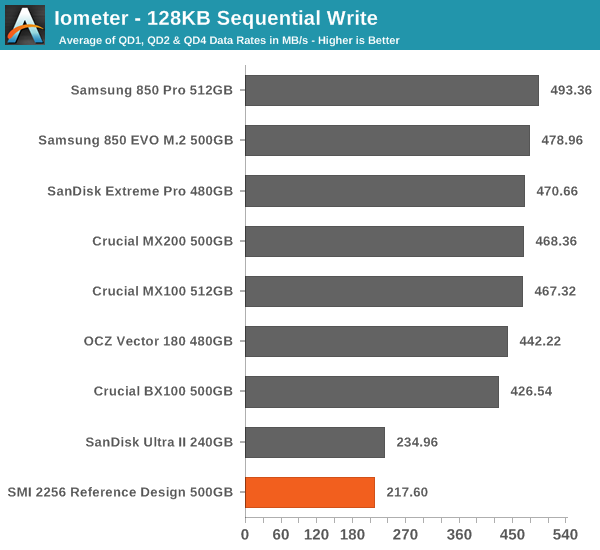
Unfortunately, sequential write performance isn't as good. Low write performance is a known quantity of TLC NAND, but given the 500GB capacity I was expecting a little more because even the Ultra II is faster despite having only half the NAND.
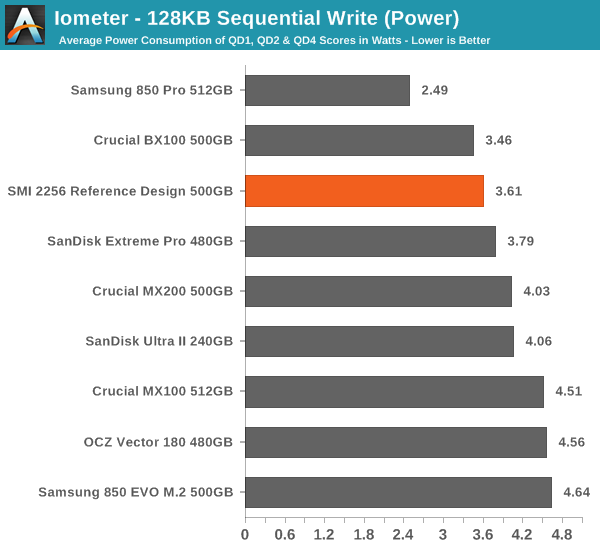
Surprisingly power consumption doesn't go up compared to the SM2246EN, but given the poor throughput the efficiency isn't anywhere near as good.
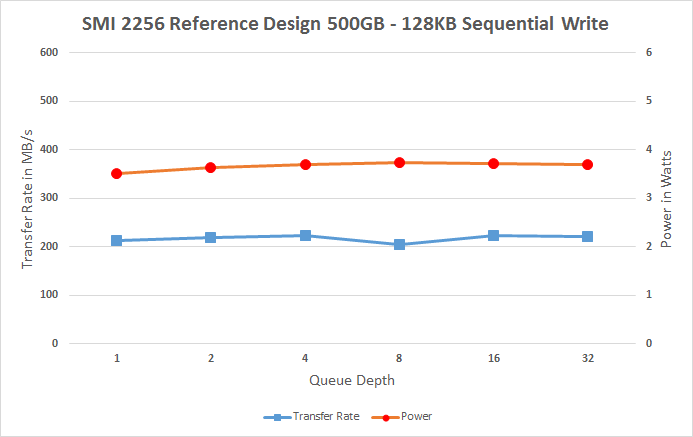 |
|||||||||










34 Comments
View All Comments
Death666Angel - Wednesday, June 17, 2015 - link
"I just can't recall a review of a flagship device that wasn't out within 2 weeks of release"Weren't most Note phones, HTC Nexus 9 and Nexus 6 pretty late or only in preview format released? Anandtech is notorious for this stuff when it comes to anything but Apple. :D Though more often than not, eventually we get something.
Michael Bay - Thursday, June 18, 2015 - link
Just two weeks?I`m still waiting for 960 review.
Oxford Guy - Thursday, June 18, 2015 - link
"TLC for everyone?" Maybe if the drives are being given away. The last time I checked MLC isn't that expensive.Oxford Guy - Thursday, June 18, 2015 - link
Samsung has had "some issues" with TLC, eh? Why not specifically state what those are?"Like all TLC SSD designs we have seen, Silicon Motion employs SLC caching in the SM2256 to improve performance and endurance. The size of the SLC cache is configurable by the OEM, but generally the cache size is between 3GB and 12GB depending on the capacity of the drive."
Actual SLC or some sort of simulated SLC?
canthearu - Thursday, June 18, 2015 - link
"Actual SLC or some sort of simulated SLC?"Both the same really. As long as it is dedicated space that will never be asked to perform TLC duty.
Oxford Guy - Saturday, June 20, 2015 - link
Isn't it rather impossible for triple layer NAND to be single layer NAND?DeepStorage - Sunday, June 21, 2015 - link
Most flash foundries have at least some models of their MLC, and TLC flash that can dedicate some percentage of the pages per die to use in SLC mode. It doesn't have quite the performance or endurance of pure SLC but it's close.Oxford Guy - Wednesday, July 15, 2015 - link
" It doesn't have quite the performance or endurance of pure SLC but it's close."Any data on that to link to?
Kristian Vättö - Thursday, June 18, 2015 - link
"TLC for everyone" meaning that now every OEM can build a TLC drive if they wish.SLC cache implementation depends on the NAND. NAND vendors do have special dies with SLC cache functionality (supports a special command set), but so far they haven't sold them to third parties, although I've heard this is about to change. In other cases SLC cache simply means that the controller only writes to the lower pages, which in terms of write performance is about the same as real SLC cache but there is some minor read performance penalty (although I don't know exactly why).
dcaxax - Thursday, June 18, 2015 - link
"admittedly Samsung has had some issues with TLC"That's the understatement of the Millenium. My 840 and 840 Evo have such severe performance degradation (60-70%) that their speed is now visibly impaired and actually compares with some of the fastest HDDs.
Considering the price per GB of an SSD that is completely unacceptable and constitutes a ripoff.
Vendors like Samsung are fobbing off substandard parts supported by immature and unreliable technology to unsuspecting customers.
This is the equivalent of a car with flashy design and big engine which is guaranteed to develop problems as soon as you drive 100 miles. They have a name for it and it's called 'a lemon'.